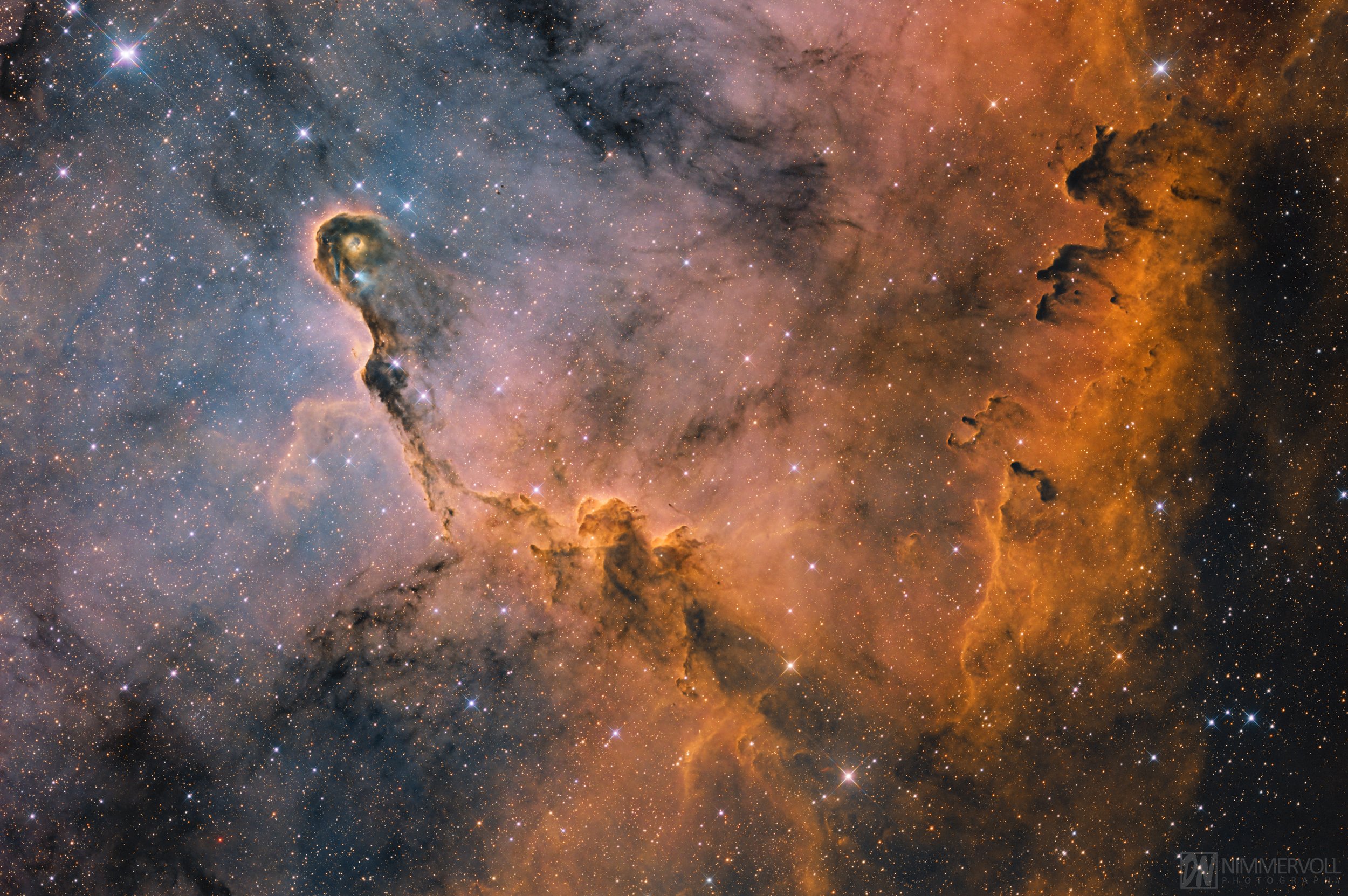
AAPOD2 Image Archives
IC 1396
IC 1396 is a stunning emission nebula located in the constellation Cepheus. The bright central star, HD 206267, ionizes the surrounding gas, causing it to glow in brilliant hues of red and blue. The nebula's distinctive shape, often referred to as the "Elephant Trunk," is created by dense columns of gas and dust that shield the nebula's interior from the ionizing radiation. The trunk of the elephant is also a site of ongoing star formation, with several young stars visible within the structure. IC 1396 is a beautiful example of the ongoing processes of stellar birth and death in our galaxy.
IC 417 - The Spider Nebula
Location: Upper AustriaPhoto taken on: December 2021Distance: 7500 light yearsExposure: RGB each 11 x 300 sec.Luminance: 30 x 300 sec.H-alpha: 51 x 900 sec.O-III: 25 x 900 sec.S-II: 58 x 900 sec.Total: 38.7 hoursCalibration: Darks / Flats / DarkFlatsMount: Skywatcher EQ6-R PROTelescope: Lacerta Fotonewton 250/1000Corrector: Lacerta GPU coma correctorFilter: Antlia LRGB-V ProAntlia 3nm Pro H-AlphaAntlia 3nm Pro O-IIIAntlia 3nm Pro S-IICamera: QHY268m @ Gain 0/60 at -15 ° CGuiding: QHY OAG with QHY5III462c and PHD2Software: APP / Photoshop CC
Copyright: Daniel Nimmervoll
SH2-129 & Ou4
Image Description and Details :
Today I want to show you my most elaborate DeepSky object. And that is SH2-129 & Ou4The Bat and Squid Nebula in the constellation of Cepheus.Ou4 is also called "the flying bat and giant squid nebula". This is the penis-like shape with the special blue-green emissions of double-ionized oxygen atoms. The squid nebula was discovered in 2011 by the French astrophotographer Nicolas Outters and is very faint.Therefore, I took all pictures with a new moon as possible.The entire field is approx. 3 degrees or 6 full moons wide! As a result, I had to make a 4-part mosaic with 6 "f / 4 Newton at 600 mm focal length. So actually a huge object in the night sky.The image processing was then again a challenge. Above all, a picture that was as natural as possible with the "right" colors was important to me. I also like star colors ---------------------------------------------Recording dates: Location: Upper AustriaRecording date: May to June 2021Distance: 2300 light yearsDiameter: 50 light yearsExposure: 122 x 300 sec. For RGB151 x 900 sec. With dual narrowbandTotal: 48 hours Calibration: Darks / Flats / DarkFlatsMount: Skywatcher EQ6-R PROTelescope: TS 6 ″ Newton Carbon 150/600Corrector: Lacerta GPU coma correctorFilters: Astronomik L2 UV-IR Block 2 ″ and Optolong Filter L-eXtreme 2 ″Camera: QHY268c @ Gain 0 at -15 ° CGuiding: ZWO OAG with QHY5III462c and PHD2Heaven: Mag. 21.67Software: APP / Photoshop CC / NHF-sharpen
Copyright: Daniel Nimmervoll
NGC1333
Image Description and Details :
RECORDING DATA:Object: NGC 1333Date of recording: November 2020Distance: 1,000 light yearsExposure: 144 x 300 sec. (Total 12 hours)Calibration: Darks / Flats / DarkFlatsMount: Skywatcher EQ6-R PROTelescope: Lacerta Fotonewton 250/1000Corrector: Lacerta GPU coma correctorFilter: Astronomik L2 UV-IR Block 2 ″Camera: QHY268c @ Gain 0 at -15 ° CGuiding: ZWO OAG with ASI 120mm-s and PHD2Software: APP / Photoshop CC
Copyright: Daniel Nimmervoll
Abell 370
Abell 370 is known for its gravitational lensing effect.
RECORDING DATA:Object: Abell 370Date of recording: November 2020 Distance: 6 billion light yearsExposure: 240 x 180 sec. (Total 12 hours)
Calibration: Darks / Flats / DarkFlats
Mount: Skywatcher EQ6-R PRO
Telescope: Lacerta Fotonewton 250/1000
Corrector: Lacerta GPU coma corrector
Filter: Astronomik L2 UV-IR Block 2 ″Camera: QHY268c @ Gain 0 at -15 °
CGuiding: ZWO OAG with ASI 120mm-s and
PHD2Resolution: 0.77 arcseconds / pixel
Software: APP / Photoshop CC
Copyright: Daniel Nimmervoll
IC 434 - Horsehead Nebula
Image Description and Details :
RECORDING DATA:Object: IC 434Recording date: November / December 2020Distance: 1,500 light yearsDiameter: 3 light yearsExposure: 75 x 300 sec. For RGB26 x 900 sec. For dual narrow bandTotal: 12.7 hoursCalibration: Darks / Flats / DarkFlatsMount: Skywatcher EQ6-R PROTelescope: Lacerta Fotonewton 250/1000Corrector: Lacerta GPU coma correctorFilter: Astronomik L2 UV-IR Block 2 ″Optolong filter L-eXtreme 2 ″Camera: QHY268c @ Gain 0/60 at -15 ° CGuiding: ZWO OAG with ASI 120mm-s and PHD2Software: APP / Photoshop CC
Copyright: Daniel Nimmervoll
The night of the stars
Image Description and Details : Exposure: per photo approx. 40 x 30 sec.Calibration: Darks / Flats / DarkFlatsMount: Skywatcher EQ6-R PROTelescope: Lacerta Fotonewton 250/1000Corrector: Lacerta GPU coma correctorFilter: Astronomik L2 UV-IR Block 2 ″Camera: QHY268c @ Gain 0 at -15 ° CGuiding: ZWO OAG with ASI 120mm-s and PHD2Software: APP / Photoshop CC
Copyright Information: Daniel Nimmervoll








